The Bulldozer Review: AMD FX-8150 Tested
by Anand Lal Shimpi on October 12, 2011 1:27 AM ESTThe Test
To keep the review length manageable we're presenting a subset of our results here. For all benchmark results and even more comparisons be sure to use our performance comparison tool: Bench.
| Motherboard: |
ASUS P8Z68-V Pro (Intel Z68) ASUS Crosshair V Formula (AMD 990FX) |
| Hard Disk: |
Intel X25-M SSD (80GB) Crucial RealSSD C300 |
| Memory: | 2 x 4GB G.Skill Ripjaws X DDR3-1600 9-9-9-20 |
| Video Card: | ATI Radeon HD 5870 (Windows 7) |
| Video Drivers: | AMD Catalyst 11.10 Beta (Windows 7) |
| Desktop Resolution: | 1920 x 1200 |
| OS: | Windows 7 x64 |
Windows 7 Application Performance
3dsmax 9
Today's desktop processors are more than fast enough to do professional level 3D rendering at home. To look at performance under 3dsmax we ran the SPECapc 3dsmax 8 benchmark (only the CPU rendering tests) under 3dsmax 9 SP1. The results reported are the rendering composite scores.

As our first heavily threaded, predominantly FP workload we see the FX-8150 come out swinging. A tangible upgrade from the Phenom II X6, the 8150 is hot on the heelds of the Core i5 2400, however it is unable to compete with the 2500K and 2600K.
Cinebench R10 & 11.5
Created by the Cinema 4D folks we have Cinebench, a popular 3D rendering benchmark that gives us both single and multi-threaded 3D rendering results.
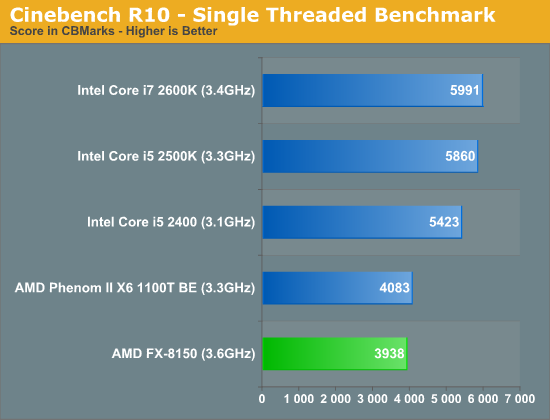
As I alluded to earlier, single threaded performance is going to be a bit of a disappointment with Bulldozer and here you get the first dose of reality. Even considering its clock speed and Turbo Core advantage, the FX-8150 is slower than the Phenom II X6 1100T. Intel's Core i5 2500K delivers nearly 50% better single threaded performance here than the FX-8150.
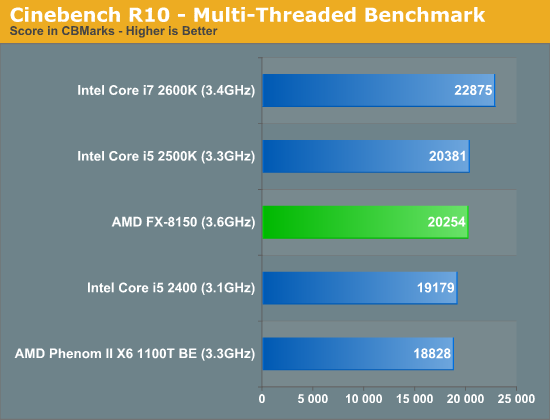
Crank up the threads and the FX-8150 shines, finally tying the 2500K at a comparable price point.
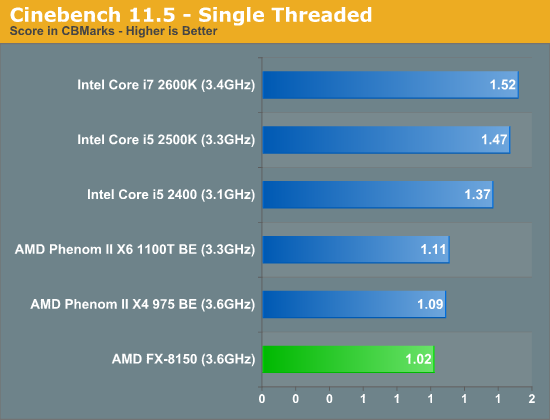
Even with more modern workloads, the FX-8150 isn't able to compete in single threaded speed. Here the 2500K is 44% faster.
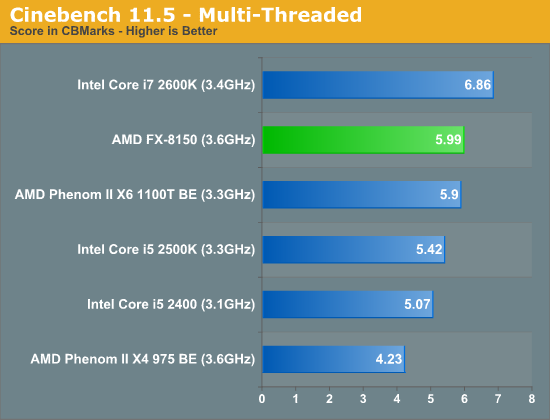
Modern multithreaded workloads however do quite well on Bulldozer. The gains over the old Phenom II X6 1100T are unfortunately not as large as we would expect them to be.
7-Zip Benchmark
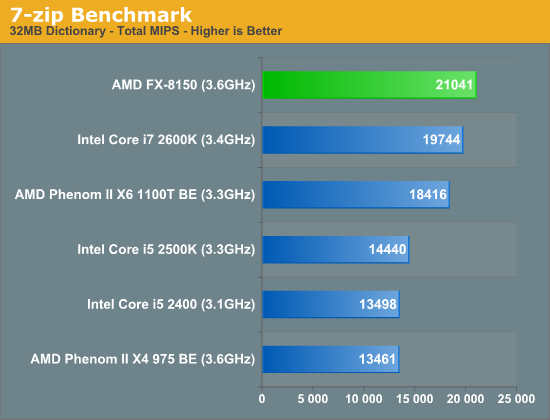
Heavily threaded workloads obviously do well on the FX series parts, here in our 7-zip test the FX-8150 is actually faster than Intel's fastest Sandy Bridge.
PAR2 Benchmark
Par2 is an application used for reconstructing downloaded archives. It can generate parity data from a given archive and later use it to recover the archive
Chuchusoft took the source code of par2cmdline 0.4 and parallelized it using Intel’s Threading Building Blocks 2.1. The result is a version of par2cmdline that can spawn multiple threads to repair par2 archives. For this test we took a 708MB archive, corrupted nearly 60MB of it, and used the multithreaded par2cmdline to recover it. The scores reported are the repair and recover time in seconds.
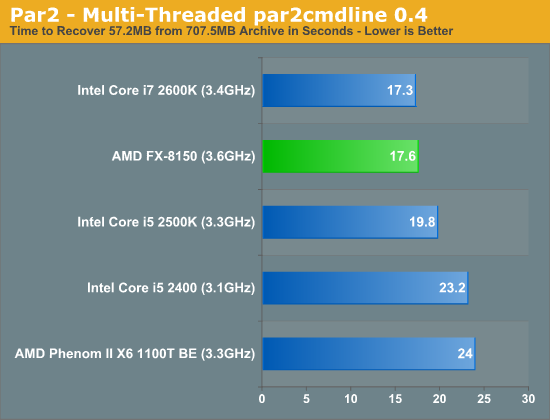
Once again, throw more threads at the processor and the FX-8150 can outperform the Core i5 2500K.
TrueCrypt Benchmark
TrueCrypt is a very popular encryption package that offers full AES-NI support. The application also features a built-in encryption benchmark that we can use to measure CPU performance with:
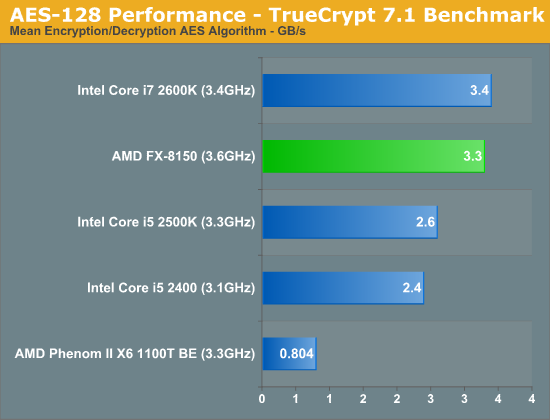
Bulldozer adds AES-NI acceleration, a feature that wasn't present in the Phenom II X6. As a result the FX-8150 is among the fastest at real time AES encryption/decryption, second only to the 2600K. Intel's artificial segmentation using Hyper Threading comes back to haunt it here as the 2500K is significantly slower than the 8-threaded beast.
x264 HD 3.03 Benchmark
Graysky's x264 HD test uses x264 to encode a 4Mbps 720p MPEG-2 source. The focus here is on quality rather than speed, thus the benchmark uses a 2-pass encode and reports the average frame rate in each pass.
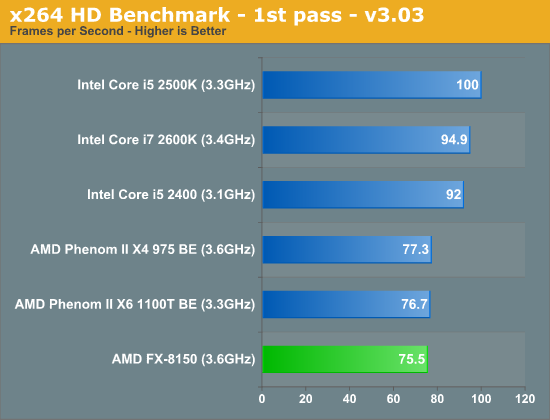
As I mentioned earlier, the first pass of our x264 HD benchmark is a lightly threaded task. As such, the FX-8150 doesn't do very well here. Even the old Phenom II is able to inch ahead of AMD's latest. And Sandy Bridge obviously does very well.

The second pass is more thread heavy, allowing the FX-8150 to flex its muscle and effectively tie the 2600K for first place.
AMD also sent along a couple of x264 binaries that were compiled with AVX and AMD XOP instruction flags. We ran both binaries through our x264 test, let's first look at what enabling AVX does to performance:
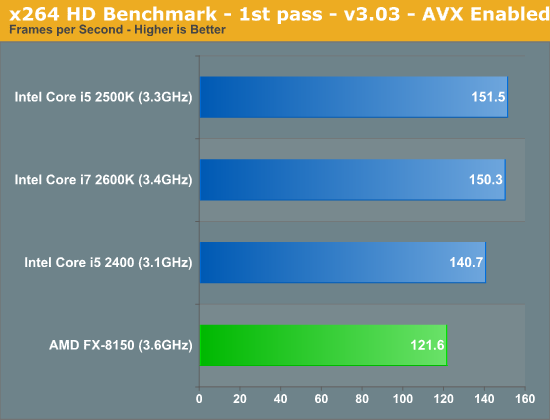
Everyone gets faster here, but Intel continues to hold onto a significant performance lead in lightly threaded workloads.
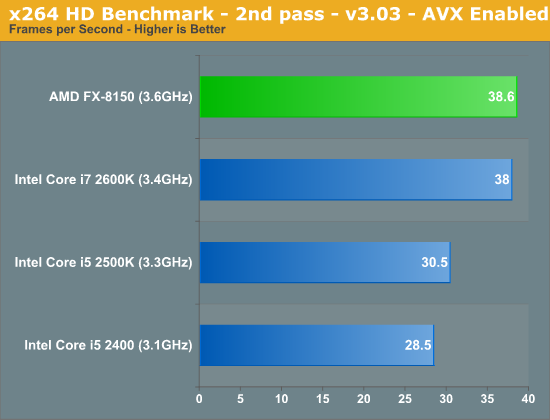
The standings don't change too much in the second pass, the frame rates are simply higher across the board. The FX-8150 is an x86 transcoding beast though, roughly equalling Intel's Core i7 2600K. Although not depicted here, the performance using the AMD XOP codepath was virtually identical to the AVX results.
Adobe Photoshop CS4
To measure performance under Photoshop CS4 we turn to the Retouch Artists’ Speed Test. The test does basic photo editing; there are a couple of color space conversions, many layer creations, color curve adjustment, image and canvas size adjustment, unsharp mask, and finally a gaussian blur performed on the entire image.
The whole process is timed and thanks to the use of Intel's X25-M SSD as our test bed hard drive, performance is far more predictable than back when we used to test on mechanical disks.
Time is reported in seconds and the lower numbers mean better performance. The test is multithreaded and can hit all four cores in a quad-core machine.
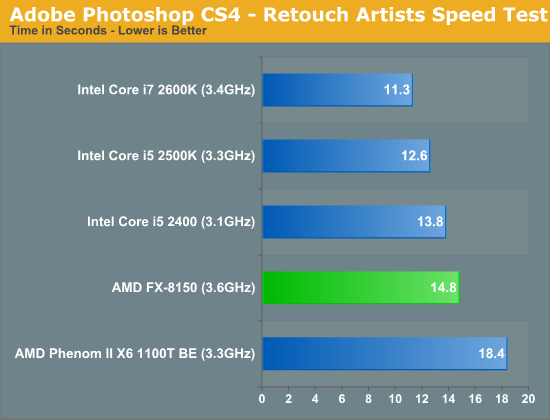
Photoshop performance improves tangibly over the Phenom II X6, unfortunately it's not enough to hang with the enthusiast Sandy Bridge parts.
Compile Chromium Test
You guys asked for it and finally I have something I feel is a good software build test. Using Visual Studio 2008 I'm compiling Chromium. It's a pretty huge project that takes over forty minutes to compile from the command line on a dual-core CPU. But the results are repeatable and the compile process will easily stress more than 8 threads on a CPU so it works for me.
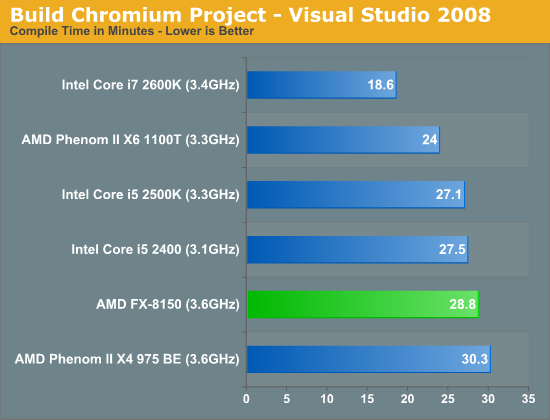
Our compiler test has traditionally favored heavily threaded architectures, but here we found the Phenom II X6 1100T to offer a tangible performance advantage over Bulldozer. While AMD is certainly competitive here, this is an example of one of those situations where AMD's architectural tradeoffs simply don't pay off—not without additional clock speed that is.
Excel Monte Carlo

Our final application test is another win for AMD over the Core i5 2500K. The victory is entirely a result of Intel's Hyper Threading restrictions though, the eight-thread 2600K is able to easily outperform Bulldozer. Either way, AMD delivers better performance here for less money.










430 Comments
View All Comments
TiGr1982 - Monday, October 17, 2011 - link
Indeed, much much better performance was expected from BD. I was an AMD focused PC buyer since 2005, at AMD "golden age", when I purchased AMD Turion-based laptop. That CPU was actually better than the corresponding Intel competitor at the moment - Pentium M Dothan, as probaly some people remember.We know the rest of the story since then till now...
But the released BD-based product in its current state seems to be barely concurrent at all on the desktop market. Presumably, its popularity will be much lower, than in case of previous Phenom II lineup...
TiGr1982 - Monday, October 17, 2011 - link
By "concurrent", I actually meant "competitive".psiboy - Tuesday, October 18, 2011 - link
Why are there no benchmarks with it overclocked... especially gaming? Would be relevant as these processors are shipping unlocked as standard.. all I'm asking for is a reasonable overclock on air to be included...eldemoledor25 - Tuesday, October 18, 2011 - link
I think they rushed all wanting to position their review as the first, if you read the other post of the network goes bullozer better positioned than the i7 2600K in many things over which a pricipio dicen.el problem was in the bios the asus and gigabyte motherboards, released immature bios fact overclock would hold more, as you may ASRock and MSI makes a bulldozer to 4.6 ghz be better than the i7 and i5 5.2GHz oc do not believe me check this and read well.1.-http: / / www.madboxpc.com/foro/topic/161318-la-verdad-sobre-el-amd-fxo-bulldozer/page__st__20
Greetings to all!!!
Martin281 - Wednesday, October 19, 2011 - link
Well, the situation among AMDs CPU is still the same...good ideas, great expectitions and manufacturing delays resulting in inappropriate results compared to Intel. Bulldozer would have been a way competitive 2 years ago, not these days. At this point AMD desperately needs way higher clock speeds and core optimizations to be competitive..the predicted 10-15% performance per watt increasing each year is really funny when compared to planned intel´s cpu roadmap (just known information that 1Q/2012 to-be-introduce ivy bridge´s TDP in top performance class is to drop from 95W to 77W, that is almost 20% only in power consumption - not to mention performance boost caused also by 22nm manufacturing process). I am worried, that the performance gap between intel and AMD cpus is going to broaden in the near future without "any light in the darkness bringing the true competition in the CPU field".siniranji - Wednesday, October 19, 2011 - link
waiting for the BD to come, but now, what a disappointment, but AMD should continue to compete with intel, otherwise, there wont be any battle to watch. I love to see a good pricing from AMD.loa567 - Wednesday, October 19, 2011 - link
I think you are wrong on one point, about the FPU. You claim that one bulldozer module has the same FP capacity as earlier AMD processors. However, in reality it has twice the (theoretical) capacity Whereas each K8/K10 core had one 128-bit FP unit, each bulldozer module has 2 x 128 bit FP units. They can work together as one 256-bit, when used with the new instructions (AVX and others). See for example this page for details: http://blogs.amd.com/work/2010/10/25/the-new-flex-...However, it is strange that this does not show in performance. Could anyone explain this to me?
Pipperox - Thursday, October 20, 2011 - link
It does show on performance.In SiSoft Sandra, 4 Bulldozer modules easily beat 6 Thuban cores.
Same goes for floating point intensive rendering tasks such as Cinebench and 3dsMax.
beck2050 - Friday, October 21, 2011 - link
"in single threaded apps a good 40-50% advantage the i5 2500K enjoys over the FX-8150."These are the apps most people use, duh.
core for core Bulldozer is epic fail. This is not going to be a popular desktop chip at all. As for servers, AMD's share has dropped from 20% to 5,5% in the last few years. I doubt this chip will be the savior.
richaron - Friday, October 21, 2011 - link
They have lost ground in the server market, so a radical new design wont make a difference...? I admire your logic.For the record I specifically look for programs/games which are multithreading, it often shows good programming on the whole. Unless of course there are other factors limiting the system (like net speed, or gpu). Perhaps I'm just ahead of the curve compared to you're average troll, duh.